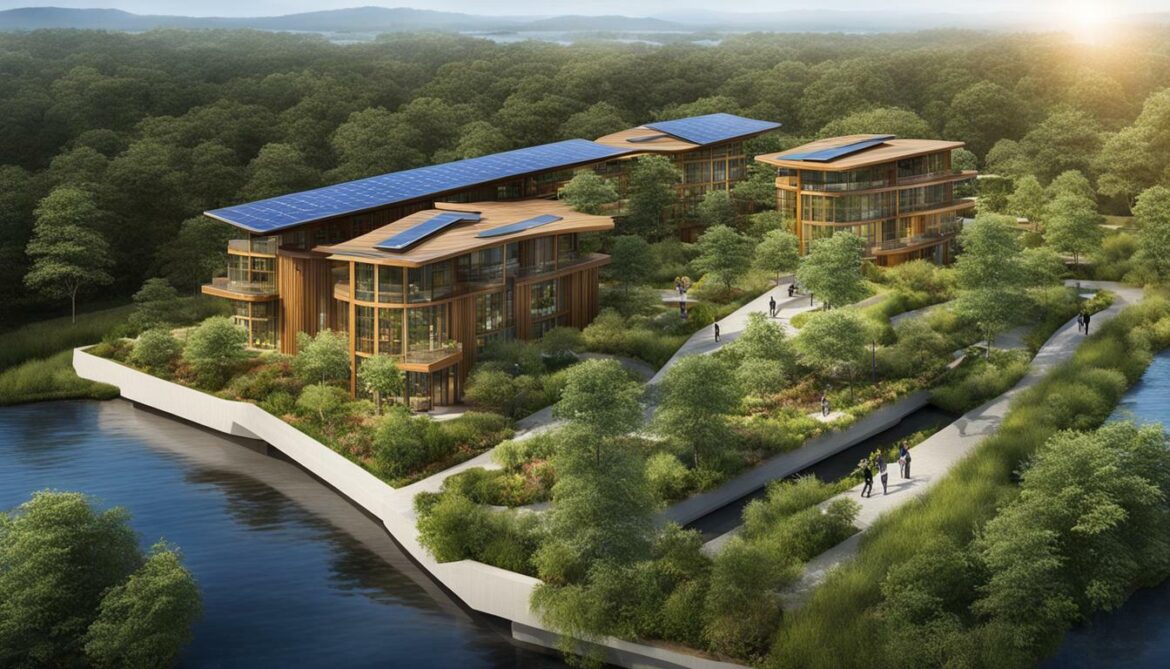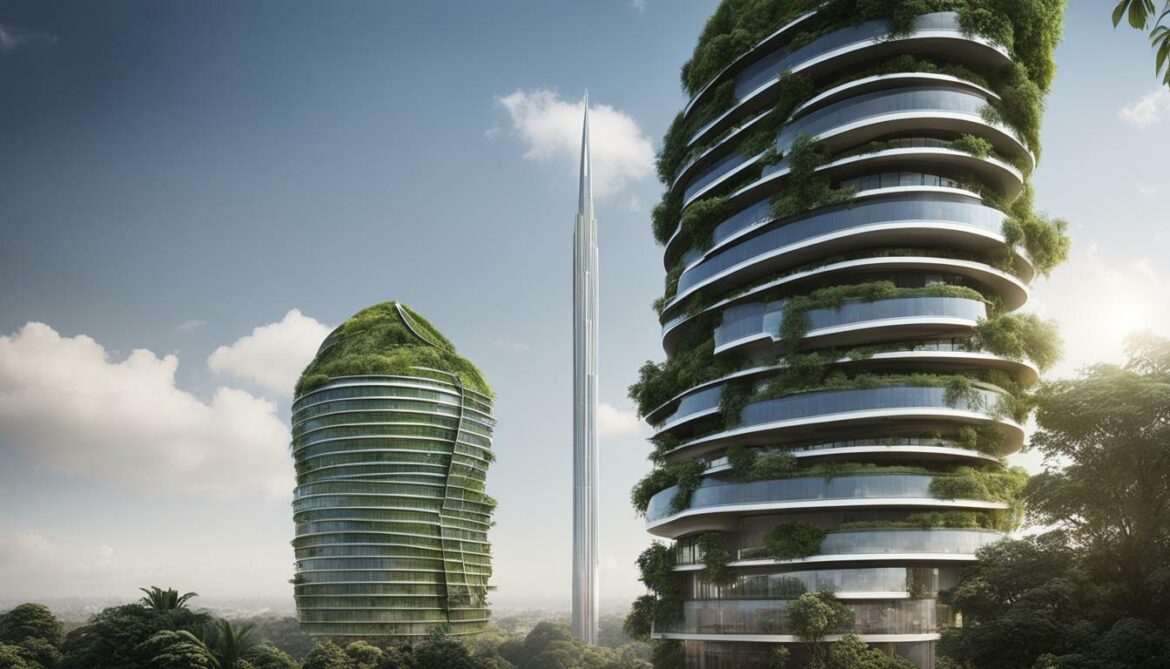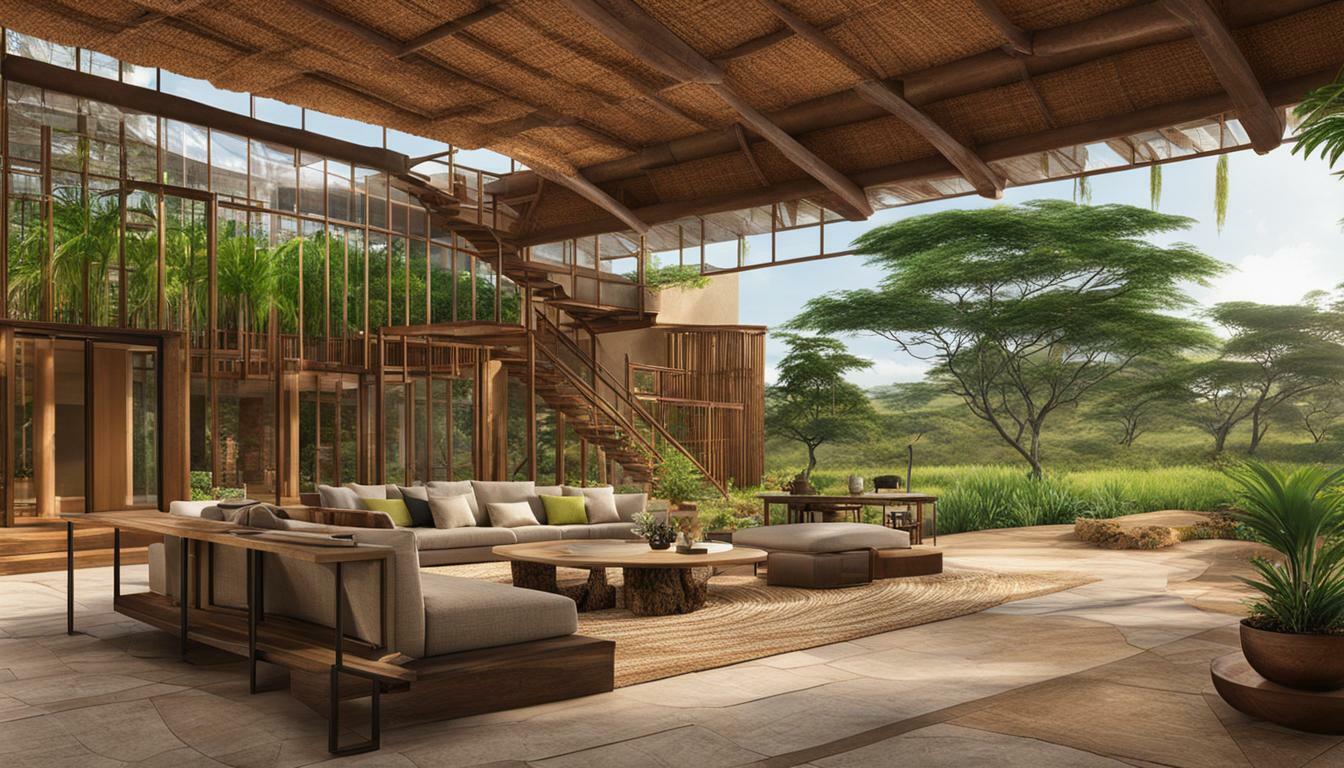Kenya has made significant strides in embracing green or environmentally sustainable architecture and construction practices, positioning itself as a leader in sustainable development in Africa. With the aim of preserving dwindling natural resources, the country has witnessed the rise of eco-friendly construction practices and sustainable development initiatives. Notable examples include the Strathmore Business School, recognized as the Best Green Building Development in Africa, and the Pope Paul VI Learning Resource Centre and Sandalwood Waterfront, both integrating green building features.
Key Takeaways:
- Kenya is at the forefront of green building and sustainable architecture in Africa.
- The Strathmore Business School is a notable example of a recognized green building project in Kenya.
- Other projects, such as the Pope Paul VI Learning Resource Centre and Sandalwood Waterfront, also incorporate eco-friendly features.
- The UNEP Nairobi building holds the distinction of being the world’s first solar-powered UN office.
- There is a growing need for well-trained personnel and increased engagement from the private sector to further drive Kenya’s green building movement.
Notable Green Building Projects in Kenya
Kenya boasts several noteworthy green building projects, including the Strathmore Business School, which has been honored as the Best Green Building Development in Africa. This innovative project incorporates sustainable design principles and eco-friendly construction techniques. The school’s campus features energy-efficient lighting, rainwater harvesting systems, and solar panels that contribute to its overall sustainability. The Strathmore Business School serves as an inspiration to other developers and showcases Kenya’s commitment to environmentally friendly construction.
Another notable green building project in Kenya is the Pope Paul VI Learning Resource Centre at The Catholic University of East Africa. This building incorporates various green features, such as efficient insulation, a rainwater collection system, and solar water heating. These elements not only reduce the building’s environmental impact but also contribute to energy and water savings.
The Sandalwood Waterfront project is also worth mentioning. Located in Mombasa, this development offers a unique blend of luxury and sustainability. The buildings are designed to optimize natural lighting and ventilation, reducing the need for artificial lighting and cooling systems. Additionally, rainwater harvesting systems and efficient waste management practices are implemented to minimize resource consumption and promote sustainable living.

| Key Features |
Benefits |
| Solar panels and energy-efficient lighting |
Reduces energy consumption and carbon footprint |
| Rainwater harvesting systems |
Conserves water and reduces reliance on the municipal supply |
| Green roofing and landscaping |
Enhances the building’s aesthetic appeal and promotes biodiversity |
Pope Paul VI Learning Resource Centre
“We wanted to create a building that not only fulfills its function as a learning center but also demonstrates our commitment to sustainable development.” – The Catholic University of East Africa
The Pope Paul VI Learning Resource Centre showcases the university’s dedication to sustainable practices. Its green features include efficient insulation, a rainwater collection system, and solar water heating. These elements contribute to energy and water savings, ensuring the resource efficiency of the building.
Sandalwood Waterfront
- Optimized natural lighting and ventilation
- Rainwater harvesting systems
- Efficient waste management practices
The Sandalwood Waterfront development demonstrates how luxury and sustainability can coexist. With its focus on energy efficiency, water conservation, and waste reduction, it sets an example for other real estate projects in Kenya.
These notable green building projects in Kenya are a testament to the country’s commitment to sustainable development. Through innovative design and eco-friendly construction practices, Kenya is paving the way for a greener future in the real estate industry.
UNEP Nairobi and Solar-Powered Buildings
The UNEP Nairobi building stands as a groundbreaking achievement, being the world’s first solar-powered UN office and a testament to Kenya’s commitment to sustainable construction. This remarkable building utilizes solar panels to harness the abundant sunlight in the region and convert it into clean, renewable energy. The decision to incorporate solar power into its design demonstrates Kenya’s dedication to reducing carbon emissions and embracing environmentally friendly practices.
The UNEP Nairobi building serves as an inspiration and a model for future construction projects, not only in Kenya but around the world. By harnessing the power of the sun, this sustainable building reduces reliance on fossil fuels and traditional energy sources. It exemplifies the potential for solar energy to revolutionize the way we construct buildings and emphasizes the importance of utilizing renewable resources in our infrastructure.

With its innovative solar-powered system, the UNEP Nairobi building showcases the feasibility of sustainable architecture and sets a new standard for environmentally conscious construction. Its success has spurred interest in solar energy and encouraged the exploration of similar initiatives in other parts of Kenya and beyond. By embracing solar power, Kenya is leading the way towards a greener future, promoting sustainable development, and inspiring others to follow suit.
Advantages of Solar-Powered Buildings
- Reduces carbon emissions and dependence on fossil fuels.
- Harnesses the abundant sunlight, a free and renewable energy source.
- Low maintenance and operating costs compared to traditional energy sources.
- Encourages sustainable development and adoption of clean technologies.
- Helps mitigate climate change and preserve the environment for future generations.
The UNEP Nairobi building serves as a shining example of what can be achieved when sustainable technologies are integrated into construction projects. It not only showcases Kenya’s dedication to environmentally conscious practices but also highlights the transformative potential of solar power in the global fight against climate change.
| Advantages of Solar-Powered Buildings |
| Reduces carbon emissions and dependence on fossil fuels. |
| Harnesses the abundant sunlight, a free and renewable energy source. |
| Low maintenance and operating costs compared to traditional energy sources. |
| Encourages sustainable development and adoption of clean technologies. |
| Helps mitigate climate change and preserve the environment for future generations. |
Challenges and Opportunities in Kenya’s Green Building Movement
While Kenya’s green building movement has gained momentum, it is not without its challenges, including the need for well-trained professionals, cost barriers, and limited private sector engagement. Efforts by organizations like the Green Africa Foundation have been instrumental in promoting green building standards and best practices in the country. However, a shortage of skilled personnel in the field remains a major hurdle in achieving widespread adoption of green technology.
Cost considerations also play a significant role in inhibiting the growth of sustainable construction projects. Despite the potential long-term cost savings associated with energy-efficient design and sustainable building materials, the initial investment required can be a deterrent for many developers. Overcoming this financial barrier will require innovative financing models and increased government support.
Furthermore, stronger engagement from the private sector is crucial for the success of Kenya’s green building movement. Encouraging more businesses to prioritize sustainability in their construction practices would not only drive market demand for green buildings but also unlock valuable resources and expertise. Collaboration between environmentalists, architectural organizations, and private entities is essential in advancing the country’s green building agenda.
Key Challenges:
- Limited availability of well-trained green building professionals
- Cost barriers associated with sustainable construction
- Limited engagement from the private sector
Opportunities:
- Efforts by Green Africa Foundation and other organizations to establish green building standards
- Potential for long-term cost savings through energy-efficient design and sustainable building materials
- Government support and development of a draft policy promoting green building standards
| Challenges |
Opportunities |
| 1. Limited availability of well-trained professionals |
1. Efforts by Green Africa Foundation and other organizations to establish green building standards |
| 2. Cost barriers associated with sustainable construction |
2. Potential for long-term cost savings through energy-efficient design and sustainable building materials |
| 3. Limited engagement from the private sector |
3. Government support and development of a draft policy promoting green building standards |
“The success of Kenya’s green building movement relies on the collaboration between environmentalists, architectural organizations, and the private sector to overcome challenges and seize opportunities in sustainable construction.”
The table above highlights the key challenges and corresponding opportunities in Kenya’s green building movement. While there are obstacles to overcome, such as the shortage of well-trained professionals and the cost barriers associated with sustainable construction, the country has the potential to position itself as a leader in green building practices by leveraging the efforts of organizations like the Green Africa Foundation and the support of the government. With increased private sector engagement and continued collaboration, Kenya can pave the way for a more sustainable future in the construction industry.

Government Policy and Future Prospects
The Kenyan government is actively working on a draft policy to promote green building standards and further the country’s sustainable construction and energy-efficient design goals. This policy aims to establish guidelines and regulations that will encourage the use of eco-friendly construction practices and the adoption of sustainable building materials. By implementing these standards, Kenya aims to position itself as a leader in sustainable construction and contribute to global efforts in combating climate change.
Environmentalists and architectural organizations are playing a crucial role in driving the green building movement forward in Kenya. Through their advocacy and educational initiatives, they are raising awareness about the benefits of sustainable construction and the need to protect the environment. These organizations are also working towards establishing green building certification programs, which will enable developers and contractors to showcase their commitment to eco-friendly practices.
However, there are challenges that need to be addressed for the full realization of green technology in Kenya. One of the main obstacles is the lack of well-trained personnel in the field of green building. Investing in training programs and educational courses focused on sustainable construction practices will help address this gap and ensure a skilled workforce that can drive the adoption of green building standards.
| Challenges |
Opportunities |
| Lack of well-trained personnel |
Investing in training programs |
| Cost considerations |
Exploring innovative financing models |
| Lack of engagement from the private sector |
Raising awareness about the benefits of green building |
The private sector also has a crucial role to play in driving the green building movement. Engaging businesses and developers in sustainable construction practices can lead to significant advancements in the adoption of green building standards. By highlighting the long-term financial benefits and environmental advantages, the private sector can be encouraged to invest in sustainable development and construction projects.
Overall, Kenya’s draft policy and the collective efforts of environmentalists, architectural organizations, and the private sector provide a promising outlook for the future of green building in the country. By overcoming the challenges and capitalizing on the opportunities, Kenya can establish itself as a global leader in sustainable construction and contribute to a greener and more sustainable future.

In conclusion, Kenya’s green building history showcases the country’s commitment to sustainable construction projects, utilizing eco-friendly practices, green construction methods, and sustainable building materials to pave the way for a more environmentally conscious future.
Kenya is slowly embracing green or environmentally sustainable architecture in real estate development due to dwindling natural resources. Some notable examples include the Strathmore Business School, which was awarded for being the Best Green Building Development in Africa. The Pope Paul VI Learning Resource Centre at The Catholic University of East Africa and Sandalwood Waterfront also incorporate green building features.
The UNEP Nairobi building is the first solar-powered UN office in the world, further highlighting Kenya’s dedication to renewable energy use. Efforts by organizations like Green Africa Foundation to create green building standards and promote green best practices are contributing to the growth of sustainable construction in the country.
However, the full realization of green technology in Kenya is hindered by a lack of well-trained personnel in the field and challenges such as the cost of sustainable building materials and a lack of engagement from the private sector. Nevertheless, the government is working on a draft policy to promote green building standards, and environmentalists and architectural organizations are striving to position Kenya as a leader in sustainable construction and energy-efficient design.
FAQ
What is the history of green building in Kenya?
Kenya has slowly embraced green or environmentally sustainable architecture in real estate development due to dwindling natural resources.
Can you give examples of notable green building projects in Kenya?
Some notable examples include the Strathmore Business School, which was awarded for being the Best Green Building Development in Africa, as well as the Pope Paul VI Learning Resource Centre at The Catholic University of East Africa and Sandalwood Waterfront.
Is there a solar-powered building in Kenya?
Yes, the UNEP Nairobi building is the first solar-powered UN office in the world.
What challenges does Kenya’s green building movement face?
The full realization of green technology is hindered by a lack of well-trained personnel in the field, and there are challenges such as the cost of materials and lack of engagement from the private sector.
What is the government doing to promote green building in Kenya?
The government is working on a draft policy to promote green building standards, and environmentalists and architectural organizations are striving to position Kenya as a leader in sustainable construction and energy-efficient design.
Source Links






















Post comments (0)